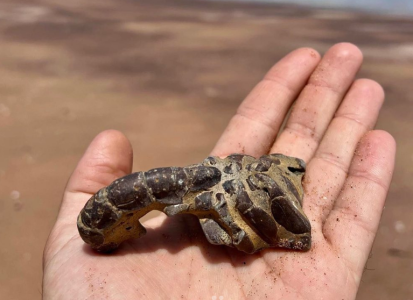Aussies stunned after ancient discovery uncovered near popular camping destination—find out what was unearthed!
By
Gian T
- Replies 0
If you’ve ever spent a lazy afternoon fishing, camping, or four-wheel driving along the sun-drenched beaches of the Top End, you might think you know every nook and cranny of your favourite spot.
But as one lucky local recently discovered, there’s still plenty of ancient magic hiding just beneath our feet—sometimes literally!
A walk to remember: The fossil find that’s got everyone talking
Gunn Point, a much-loved camping and fishing destination north of Darwin, is usually abuzz with the sound of 4WDs, the laughter of families, and the gentle crash of waves. But for Susie Clarke, a simple stroll along the sand turned into a moment of pure excitement when she stumbled upon something extraordinary: the fossilised remains of a mud lobster, perfectly preserved in rock.
‘It was so exciting. I was like a three-year-old kid jumping up and down,’ Susie shared, her delight infectious. Originally from Wales, Susie has made a hobby of beachcombing for fossils since moving to Australia, but she says this is the most complete crustacean she’s ever found. Discovered nestled among a bed of shells, her find quickly became the talk of the town—and the internet—with dozens of fellow Aussies sharing in her joy.
‘Wowsers, what an awesome find,’ one person commented online. Another reminisced, ‘OMG, we used to get them all the time when I was a kid. I still have them.’
A fossil with a story: What exactly did Susie find?
So, what’s the big deal about this ancient crustacean? According to Peter Davie, Senior Curator of Crustacea at the Queensland Museum, Susie’s discovery is the exoskeleton of a mud lobster (Thalassina squamifera). These fascinating creatures can grow to the size of a human hand and, with their scorpion-like appearance, look nothing like the lobsters you’d find at your local seafood restaurant.
Like spiders and insects, mud lobsters shed their exoskeletons as they grow. Over thousands of years, silt and iron compounds seep into these empty shells, preserving them in remarkable detail. In fact, it’s not uncommon to find mud lobster remains in the Darwin area that are between 5,000 and 8,000 years old!
Why are these fossils so well-preserved?
The secret lies in the mud lobsters’ unusual lifestyle. These shy, nocturnal creatures are rarely seen because they spend most of their lives hidden in elaborate mud mounds—some reaching up to three-quarters of a metre tall—in the mangroves. Their burrows are interconnected, and the rich, microorganism-packed mud delivered by the tides means they hardly ever need to venture outside.
Because they’re so reclusive, their discarded exoskeletons often remain undisturbed, allowing sediment to settle and ‘concrete’ around them, preserving their shape for millennia. As Peter Davie explains, ‘They’re not being disturbed by anything else or tumbled about. It’s the perfect environment for allowing the sediment to concrete around and preserve it.’
A window into Australia’s ancient past
Fossil finds like Susie’s are more than just a curiosity—they’re a tangible link to Australia’s deep natural history. They remind us that our favourite camping and fishing spots have been home to remarkable creatures for thousands of years, long before the first tyre tracks ever marked the sand.
And it’s not just mud lobsters! Australia’s wild places are full of hidden wonders, from ancient megafauna bones to mysterious patterns etched into the landscape by wind, water, and time. Every discovery, big or small, adds another piece to the puzzle of our country’s unique environment.
Tips for beachcombers: How to spot your own ancient treasure
Inspired to do a little fossicking of your own next time you’re out and about? Here are a few tips:
- **Look where others don’t:** Fossils and ancient remains are often found in less-travelled areas, especially after storms or high tides.- **Check among shells and rocks:** Fossilised remains can blend in with shell beds or be partially buried in sand.- **Be respectful:** If you find something unusual, take a photo and consider reporting it to your local museum or park authority. Some finds may be protected by law.- **Share the excitement:** Whether it’s a fossil, a shell, or a quirky rock, sharing your discovery can inspire others to appreciate Australia’s natural wonders.
Have you ever found something surprising while camping or beachcombing? Maybe a fossil, an unusual shell, or even a relic from days gone by? We’d love to hear your stories—share them in the comments below!
Australia’s wild side: Why we love our weird and wonderful environment
From ancient mud lobsters to giant kangaroos and mysterious outback wells, Australia’s landscape is a treasure trove of the strange and spectacular. It’s one of the many reasons we love getting out and about, whether it’s for a weekend camping trip or a simple stroll along the beach.
So next time you’re at your favourite spot, keep your eyes peeled—you never know what ancient secret might be waiting just beneath the surface!

But as one lucky local recently discovered, there’s still plenty of ancient magic hiding just beneath our feet—sometimes literally!
A walk to remember: The fossil find that’s got everyone talking
Gunn Point, a much-loved camping and fishing destination north of Darwin, is usually abuzz with the sound of 4WDs, the laughter of families, and the gentle crash of waves. But for Susie Clarke, a simple stroll along the sand turned into a moment of pure excitement when she stumbled upon something extraordinary: the fossilised remains of a mud lobster, perfectly preserved in rock.
‘It was so exciting. I was like a three-year-old kid jumping up and down,’ Susie shared, her delight infectious. Originally from Wales, Susie has made a hobby of beachcombing for fossils since moving to Australia, but she says this is the most complete crustacean she’s ever found. Discovered nestled among a bed of shells, her find quickly became the talk of the town—and the internet—with dozens of fellow Aussies sharing in her joy.
‘Wowsers, what an awesome find,’ one person commented online. Another reminisced, ‘OMG, we used to get them all the time when I was a kid. I still have them.’
A fossil with a story: What exactly did Susie find?
So, what’s the big deal about this ancient crustacean? According to Peter Davie, Senior Curator of Crustacea at the Queensland Museum, Susie’s discovery is the exoskeleton of a mud lobster (Thalassina squamifera). These fascinating creatures can grow to the size of a human hand and, with their scorpion-like appearance, look nothing like the lobsters you’d find at your local seafood restaurant.
Like spiders and insects, mud lobsters shed their exoskeletons as they grow. Over thousands of years, silt and iron compounds seep into these empty shells, preserving them in remarkable detail. In fact, it’s not uncommon to find mud lobster remains in the Darwin area that are between 5,000 and 8,000 years old!
Why are these fossils so well-preserved?
The secret lies in the mud lobsters’ unusual lifestyle. These shy, nocturnal creatures are rarely seen because they spend most of their lives hidden in elaborate mud mounds—some reaching up to three-quarters of a metre tall—in the mangroves. Their burrows are interconnected, and the rich, microorganism-packed mud delivered by the tides means they hardly ever need to venture outside.
Because they’re so reclusive, their discarded exoskeletons often remain undisturbed, allowing sediment to settle and ‘concrete’ around them, preserving their shape for millennia. As Peter Davie explains, ‘They’re not being disturbed by anything else or tumbled about. It’s the perfect environment for allowing the sediment to concrete around and preserve it.’
A window into Australia’s ancient past
Fossil finds like Susie’s are more than just a curiosity—they’re a tangible link to Australia’s deep natural history. They remind us that our favourite camping and fishing spots have been home to remarkable creatures for thousands of years, long before the first tyre tracks ever marked the sand.
And it’s not just mud lobsters! Australia’s wild places are full of hidden wonders, from ancient megafauna bones to mysterious patterns etched into the landscape by wind, water, and time. Every discovery, big or small, adds another piece to the puzzle of our country’s unique environment.
Tips for beachcombers: How to spot your own ancient treasure
Inspired to do a little fossicking of your own next time you’re out and about? Here are a few tips:
- **Look where others don’t:** Fossils and ancient remains are often found in less-travelled areas, especially after storms or high tides.- **Check among shells and rocks:** Fossilised remains can blend in with shell beds or be partially buried in sand.- **Be respectful:** If you find something unusual, take a photo and consider reporting it to your local museum or park authority. Some finds may be protected by law.- **Share the excitement:** Whether it’s a fossil, a shell, or a quirky rock, sharing your discovery can inspire others to appreciate Australia’s natural wonders.
Have you ever found something surprising while camping or beachcombing? Maybe a fossil, an unusual shell, or even a relic from days gone by? We’d love to hear your stories—share them in the comments below!
Australia’s wild side: Why we love our weird and wonderful environment
From ancient mud lobsters to giant kangaroos and mysterious outback wells, Australia’s landscape is a treasure trove of the strange and spectacular. It’s one of the many reasons we love getting out and about, whether it’s for a weekend camping trip or a simple stroll along the beach.
So next time you’re at your favourite spot, keep your eyes peeled—you never know what ancient secret might be waiting just beneath the surface!
Key Takeaways
- A local woman, Susie Clarke, discovered a remarkably intact mud lobster fossil embedded in rock while strolling at Gunn Point, north of Darwin.
- The fossil, believed to be thousands of years old, generated excitement on social media, with people sharing memories and expressing delight at the rare find.
- According to Peter Davie from Queensland Museum, mud lobsters (Thalassina squamifera) are shy, nocturnal creatures that live in interconnected mud mound burrows in mangroves, which helps preserve their exoskeletons after they moult.
- Ancient mud lobster remains, dating back 5,000 to 8,000 years, are commonly found in the area due to their hidden, undisturbed lifestyle, but living specimens are seldom seen in the wild.








